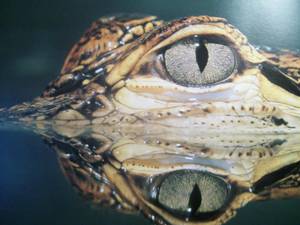
Articles
Alligator Farms
Characteristics
Conservation
Diet
Facts
Reproduction
Safety
American Alligator Characteristics
The alligators are reptiles of the family Alligatorinae the order of the Crocodilians. They are Animals very similar to the crocodiles, which are distinguished by the short and wide head and by the presence of interdigital membranes in the thumbs of the hear paws. Regarding the teething, the fourth canine tooth of the inferior jaw fits in a hole of the superior jaw, whereas in the crocodiles it stands far out, when they have the mouth shut. The alligators inhabit the Americas and had disappeared from Europe in the Pliocénico. In North America one type of Alligator exists exclusively.

American Alligators of 5 - 6 meters (16 - 20 feet) have been recorded in the past but today an adult male of 4 meters (13 feet) is considered large.
Juvenile Alligators are black with 10 - 11 narrow yellow crossbands on the tail and 4 - 5 on the body.
As they grow larger the crossbands fade and in adults, are rarely visible on the body. The eyes are normally silverish in color. The snout is moderately long and wide, generally uniform in width, with a bony nasal bridge. Some of the characteristics that vary among individuals are the presence or absence of bony plates or buttons (osteoderms) in the thoracic or ventral scales, the shape of the snout, and the massiveness of the skull.
Alligators are like other reptiles. They have scaly skin. They lay eggs with shells, and they are cold - blooded. Alligators can grow to be twelve or fourteen feet long and weigh from just a few pounds to more than 2,000 pounds. An eight - foot alligator is unusual in the wild.
Young alligators are actually dark brown or black. They have yellow bands or marks on their bodies. As the alligators ages the marks fade. The adult alligator’s blackish or dark gray skin is made up of scales __-thin, hard plates of varying size and shape. The scales run down the alligator’s body in rows and are joined by narrow bands of heavy, wrinkled skin. Large scales on the alligator’s back and neck make the alligator’s skin look like armor, the protective coat that soldiers once wore in battle. The scales rise into ridges in the center and are strengthened inside with bony material.
The scales on the alligator’s belly are also tough, but they’re smooth and flat and don’t have bony ridges on them.
The alligator‘s tough, leathery skin protects it from the roughness of the ground. Long ago in the age of dinosaurs, this thick skin probably also protected the alligator’s ancestors from large predators, animals that hunt other animals for food. Today those enemies no longer exist, but the alligator’s tough skin remains.
An alligator’s legs are short and its body is long and heavy. You’d think that would make an alligator’s movements clumsy and slow. Not so. In the water, an alligator is graceful and fast. It uses its short legs and webbed feet to steady itself __just as you use your hands and arms to steady yourself when you float.
To swim, the alligator tucks its legs close to its body and sweeps its tail from side to side. At top speed, an alligator can move through the water much faster than a person padding a canoe.
Alligators spend much of their lives in water. For swimming they have streamlined bodies and webbed feet, just as otters and ducks do. The tail is used like a paddle. It also steers the animal and gives it power in the water.
They are nature's submarines. They can cruise on the surface of a lake or river or dive below.When an alligator dives, it is able to close its nose, throat, and ear openings. This keeps water from pouring into the animal.
On land crocodilians are awkward. Still. They have to come onto land to build nests, lay eggs, and rest. Often hey crawl on their bellies. However, they can raise themselves on their feet and move quickly when they need to.
American alligators have been known to walk ten miles looking for water. It can run fast for short distances, but it tires quickly and must stop to rest. Even so, an alligator sometimes travels long distances overland to find a new home.
Alligators are not as active as crocodiles. In fact they appear to be slow, sleepy animals. They are usually seen floating quietly in the water or resting on a muddy shore.
Nevertheless, Alligators can move surprisingly fast, and they can be very dangerous.

The alligator’s eyes are on top of its skull. This can be quite useful. The alligator can see above the water. It does this while the rest of its body is underwater. So alligators can see you before you can see them. Look out!
The eye of an alligator. The pupil is slit – like in bright sun; at night, it expands greatly to allow more light to enter the eye. Crocodilians have moveable eyelids and a transparent third eyelid, which covers the eye when they are submerged.